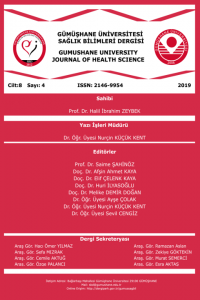Abstract
Kırmızı biber anavatanı tropik Amerika
olup,Türkiye’ de çoğunlukla Akdeniz, Ege, Marmara ve Güneydoğu Anadolu
bölgelerinde yetiştirilen, Solanaceae familyasına ait olan Capsicum annuum L.
türünden bir sebzenin kurutularak öğütülmesi sonucu elde edilen bir baharattır.
Yemeklere lezzet ve acılık vermek amacıyla ve ayrıca sanayi hammaddesi olarak
başta konserve, salça, turşu, acı sos, işlenmiş et ürünlerinde kurutulmuş, toz
ve pul biber şeklinde kullanılmaktadır. Kırmızıbiberin etken maddesi kapsaisin
ve kapsinoidlerdir. 10 g kırmızıbiber, 30 mg kapsaisin içerir. Çalışmalarda
kırmızıbiberin lipid metabolizması, diyabet, sindirim sistemi üzerine olumlu
etkileri olduğu bilinmekte, ayrıca, anti-oksidant ve anti-inflamatuar
özellikleri olduğu da belirtilmektedir. Kapsaisin ve kapsinoidlerin enerji ve
lipid metabolizması üzerine etkisinin Sempatik Sinir Sistem (SNS) aktivasyonu
ile Transient Reseptör Potansiyel Vanilloid 1 (TRPV1) aracılığı ile
termogenezisi artırarak gerçekleştirdiği bulunmuştur. Kapsaisin, postprandiyal
durumda SNS stimülasyonu ile plazma nöradrenalinini %27 ve lipid oksidasyonunu
%72 artırdığı bildirilmektedir. Kapsaisinin bu etkilerinin yanı sıra besin
alımını azaltma ve doygunluğu artırma üzerine etkilerini değerlendiren
çalışmalar da vardır. Bu çalışmalarda bir sonraki öğünde besin alımındaki
azalmanın kapsaisinin sempatik:parasempatik sistem aktivasyonunu artırması ile
ilişkili olduğu gösterilmiştir. Doygunluğu artırıcı etkisinin ise kapsaisinin
gastrik peptidlerin salınımını artırması aracılığı ile olduğu düşünülmektedir.
Kapsaisinin doygunluğu artırmanın yanı sıra gastrik boşalmayı geciktirerek
postprandiyal glisemik cevabı etkilediği bildirilmiştir.
References
- 1. Değirmencioğlu, Y. Yaman, M. Şimşek, I. (2007). “Kadınların baharat kullanım alışkanlıkları üzerine bir araştırma”. TSK Koruyucu Hekimlik Bülteni, 6:161-168.
- 2. Duman, A.D. Zorlugenç, B. Evliya, B. (2002). “Kahramanmaraş'ta Kırmızıbiberin Önemi ve Sorunları”. KSÜ Fen ve Mühendislik Dergisi, 5:111-117.
- 3. Kawabata, F. Inoue, N. Masamoto, Y. et al. (2009). “Non- pungent capsaicin analogs ( Capsinoids) increase metabolic rate and enhance thermogenesis via gastrointestinal TRPV1 in mice”. Biosci. Biotechnol. Biochem.,73: 2690- 2697.
- 4. Aslan, M. Orhan, N. (2010). “Obezite tedavisinde yardımcı olarak kullanılan doğal ürünler”. Mised, 23: 91-105.
- 5. Srinivasan, K. (2005). “Spices as influncers of body metabolism: an overview of three decades of research”. Food Research International, 38: 77- 86.
- 6. Chandrasekhara, N. Srinivasan, K. (1999). “Health benefits of spices”. InRecent trends in food science and technology – Globalperspective(pp. 725–737). Mysore: Association of Food Scientists& Technologists.
- 7. Srinivasan, K. (2000). “Spices: Valued for more than taste and flavour of foods”. In A. K. De (Ed.), Recent trends in spices and medicinal plants research (pp. 31–38). New Delhi: Associated Publishing Co.
- 8. Srinivasan, K. (2004a). “Spices as nutraceuticals with multi-beneficial health effects”. Journal of Herbs Spices and Medicinal Plants, 11.
- 9. Srinivasan, K. (2004). “Plant foods in the management of diabetes mellitus: spices as potential antidiabetic agents”. International Journal of Food Science and Nutrition, 6: 399-414.
- 10. Srinivasan, K. Sambaiah, K. Chandrasekhara, N. (2004). “Spices as beneficial hypo-cholesterolemic food adjuncts: a review”. Food Reviews International, 20: 187–220.
- 11. Kovacs, E.M.R. Mela, D.J. (2006). “Metbolically active functional food ingredients for weight control”. Obesity Reviews, 7: 59-78.
- 12. Prakash, U.N.S. Srinivasan, K. (2012). “Fat digestion and absorption in spice-pretreated rats”. Journal of the Science of Food and Agriculture, 92: 503-510.
- 13. Yoshioka, M. Doucet, E. Dionne, V.I. Trembly, A. (2001). “Combined effects of red pepper and caffeine consumption on 24h energy balance in subjects given free access to foods”. British Journal of Nutrition, 85:203-211.
- 14. Yoshioka, M. St- Pierre, S. Drapeau, V. et al. (1999). “Effect of red pepper on appetite and energy intake”. British Journal of Nutrition, 82: 115-123.
- 15. Bley, K.R. Malmberg, A.B. (2005). “TRPV1 agonist-based therapies: mechanism of action and clinical prospects”. Annika B. (Ed.). Turning up the Heat On Pain: TRPV1 Receptors in Pain and Inflammation (191-209). Birkhäuser Verlag Basel/Switzerland.
- 16. Şener, E. Şahin, S. (2010). “Kapsaisin: Farmakokinetik, toksikolojik ve farmakolojik özellikleri”. Hacettepe Üni. Eczacılık Fak. Dergisi, 29: 149-163.
- 17. Lejeune, M.P.G.M. Kovacs, E.M.R. Westerterp- Plantenga, M.S. (2003). “Effect of capsaicin on substrate oxidation and weight maintenance after modest body -wieght loss in human subjects”. British Journal of Nutrition, 90: 651-659.
- 18. Yoshioka, M. Lim, K. Kikuzato, S. et al. (1995). “Effects of red-pepper diet on the energy metabolism in men”. Japan Journal of Nutritional Science and Vitaminology, 41(6):647-656.
- 19. Janssens, P.L.H.R. Hursel, R. Westerterp-Plantenga, M.S. (2014). “Capsaicin increases sensation of fullness in energy balance, and decreases desire to eat after dinner in negative energy balance”. Appetite, 77C: 44-49.)
- 20. Whiting, S. Derbyshire, E.J. Tiwari, B. (2014). “Could capsaicinoids help to support weight management?A systematic review and meta-analysis of enregy intake data”. Appetite, 73: 1832-1838.
- 21. Belza, A. Frandsen, E. Kondrup, J. (2007). “Body fat loss achieved by stimulation of thermogenesis by a combination of bioactive food ingredients: a placebo-controlled, double-blind 8-week intervention in obese subjects”. International Journal of Obesity, 31: 121–130.
- 22. Ahuja, K.D.K. Robertson, I.K. Geraghty, D.P. Ball, M.J. (2006). “Effects of chili consumption on postprandial glucose, insulin and energy metabolism”. American Journal of Clinical Nutrition, 84: 63-9.
- 23. Yuan, L.J. Qin, Y. Wang, L. et al. (2016). “Capsaicin-containing chili improved postprandial hyperglycemia, hyperinsulinemia, and fasting lipid disorders in women with gestational diabetes mellitus and lowered the incidence of large-forgestational-age newborns”. Clinical Nutrition, 35: 388-393.
- 24. Imaizumi, K. Sato, S. Kumazawa, M. et al. (2011). “Capsicinoids-induced changes of plasma glucose, free fatty acids and glycerol concentrations in rats”. The Journal of Toxicological Sciences, 36(1): 109-116.
- 25. Van Avesaat, M. Troost, F.J. Westerp-Plantenga, M.S. et al. (2016). “Capsaicin-induced satiety is associated with gastrointestinal distress but not with the release of satiety hormones”. American Journal of Clinical Nutrition, 103: 305-313.
- 26. Galgani, J.E. Ryan, D.H. Ravussin, E. (2010). “Effect of capsinoids and energy metabolism in human subject”. British Journal of Nutrition, 103: 38- 42.
Details
| Primary Language | Turkish |
|---|---|
| Subjects | Health Care Administration |
| Journal Section | Derlemeler |
| Authors | |
| Publication Date | December 31, 2019 |
| Published in Issue | Year 2019 Volume: 8 Issue: 4 |

